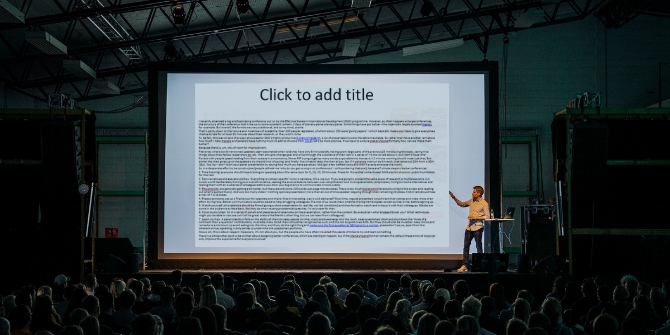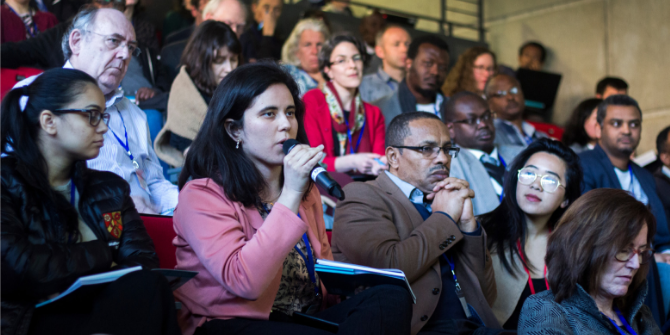For many researchers, 2020 will have been the first year in which they have attended any virtual academic events. In this cross-post Gina Sipley reflects on the advantages and disadvantages of virtual conferences and whether they may become a permanent fixture of the post-pandemic university.
In January when I saw the call for papers for the 2020 Association of Internet Researchers (AoIR) Conference in Dublin, I was faced with what has become a common dilemma: can I afford to go? As a tenured community college professor in New York, I have limited access to institutional funds and I am responsible for funding my professional development largely through my own ingenuity. To attend a conference is a question of economics, but also of social cost.
The date of the AoIR conference coincided with both my son’s fifth birthday and Halloween. To fly to Ireland would require the logistical gymnastics of hiring additional childcare for my infant son. The 2021 AoIR conference was slated for Philadelphia, a two hour drive from my home. The cost of travel would be reasonable and I could bring my family and stay in the guest room of a friend who lives just outside the city. Despite these practicalities, my research on lurker literacy practices in neighbourhood Facebook groups was timely, particularly given the impact of Facebook on the, at that time, yet to be determined U.S. election. Still uncertain, I decided to submit my materials and think through the details later. Then, COVID closed international borders and like every other 2020 conference, AoIR moved online.
To attend a conference is a question of economics, but also of social cost.
Despite my initial disappointment, AoIR 2020 proved to be one of the best conferences I’ve ever attended. The executive board creatively re-designed the conference to minimize screen fatigue and maximize interactivity. Instead of an intense almost week long event, the conference was spread out over the course of a month. Presenters developed 3 minute videos that overviewed their research. AoIR curated these videos into playlists by theme and they were made available to participants at the beginning of the month, giving participants three weeks to view them. During the week originally slated for the conference there were themed breakout sessions, three per day across time zones, to allow participants to discuss the presentation videos. The Doctoral Colloquium was held on Slack. Keynotes were scheduled to maximize synchronous participation across a range of time zones. AoIR utilized GatherTown to create a virtual series of pubs that were open 24 hours per day for participants to meet and video chat. Each day had at least one social event, from pub quizzes to karaoke to a Ceili (an Irish folk dance).
This clever design insured that there was a balance among synchronous, asynchronous, and serendipitous participation. I could allot 15 minutes each night to asynchronously listening to the playlists, while emptying my dishwasher, taking note of the scholarship that intrigued me. As in years past, AoIR published Selected Papers of Internet Research where I could later look up the presenters, their bibliographies, and identify people I wanted to connect with. I could synchronously listen to the keynote, while also giving my son a bottle and following the Twitter backchannel. I serendipitously joined a pub quiz team through Slack with scholars I had no pre-existing relationship with. I wandered into a virtual pub and plopped down at an open seat to engage in conversation both casual and professional with other participants. After the closing ceremonies I began to wonder, would academic organizations continue offering virtual conferences?
An in-person conference offers the luxury of leaving your campus and your home life for a few days to immerse yourself in new ideas and reacquaint with colleagues and old friends. It’s a chance to make critical connections and a time to recharge. The benefits to in-person conferences are many. The problem is they are consistently accessible to few.
Access to institutional funds is dwindling. Each year it becomes more challenging to secure professionalisation funds. As full time faculty, I earn a living wage and funding my travel through a series of creative calculations is sometimes possible (e.g. Can my partner and I arrange to attend the same conference and split the hotel costs? Can I negotiate an extra day of course coverage to drive rather than fly?). Even if you are fortunate to have access to adequate institutional funds, those funds are often acquired through reimbursement. This means that you must have cash reserves available to finance your conference expenditures in advance. Often the bureaucracy surrounding reimbursement is not finalised until after the event has taken place. Scholars attending international conferences, particularly those from low or middle income countries, navigate the additional hurdles of costly visas and visa restrictions that might prohibit their attendance altogether. Adjunct and contingent faculty striving for an elusive full time position are put in the outrageous position of choosing whether to attend events that will further impoverish them or skip out altogether and thus become less marketable.
as organizations begin to plan events in a truly post-COVID world, it is imperative to consider virtual as a “location” site, among other geographic locales, for future conferences
Virtual conferences can also be more accessible to people with disabilities. As someone with chronic pain related to Ichthyosis, a rare skin condition, my typical in-person conference routine includes budgeting time to insulate my body prior to my presentation. I sometimes run into challenges like during the Modern Language Association Convention 2018 when a snow squall befell New York City. Since I could reasonably commute to the conference from my home, I took public transportation to diminish the overall cost. Due to weather delays, I wound up walking the last mile to the conference in the snow. When I arrived late to my presentation, I did not have the necessary time to prepare my body. When you’re in pain, it’s hard to think clearly. I gave my talk in a faint wavering voice as I tried to focus on my prepared remarks. Although my specific condition is rare, the experiences of people with highly visible and less visible disabilities is not.
Online conferences, even if fees remain the same, eliminates the need for costly air travel. There is a great irony that most academic disciplines are engaging in discussions of how to mitigate the global climate crisis, yet we continue to expect scholars to traverse the globe several times a year to stay relevant. Where you could possibly try to limit travel to regional events, the most prestigious academic conferences continue to meet in the Western Hemisphere making it impossible for participants from the Global South to join via any other form of transportation.
Many academic organizations contract with hotels and conference centers several years in advance, thus it will be difficult for organizations under contract to pivot to a fully virtual conference in the interim between full COVID lockdown and partial reopening. However, as organizations begin to plan events in a truly post-COVID world, it is imperative to consider virtual as a “location” site, among other geographic locales, for future conferences. Fully virtual academic conferences are more equitable, accessible, and sustainable. I look forward to the possibility of fully virtual conferences becoming normalized location sites.
This post first appeared on the Post-Pandemic University blog.
Note: This article gives the views of the author, and not the position of the LSE Impact Blog, nor of the London School of Economics. Please review our comments policy if you have any concerns on posting a comment below
Image Credit: Skitterphoto via Pexels.








